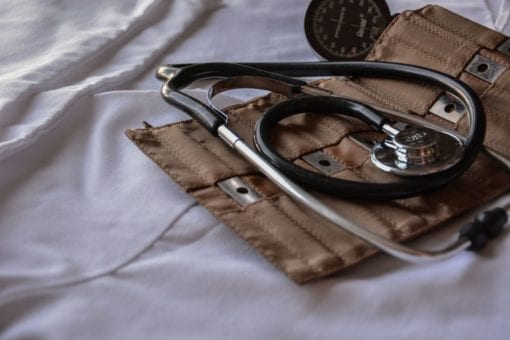Content warning for weight stigma in the medical field
I had gone into her office because I had a sinus infection. I left with a prescription for antibiotics and a referral to a seminar at a bariatric surgery clinic.
It was my first time seeing this nurse practitioner. My normal doctor was not available, so the receptionist asked if I was okay with seeing her. “Sure,” I said, through a thick wall of DayQuil and mucous. I was an open and shut case. This appointment should be quick and easy, I thought. And it was all standard when my name was called: an assistant took my temperature (101.3 degrees) and blood pressure (a little higher than usual, but within normal limits) and weight. I figured I was on the fast track to getting antibiotics, a note for missing work, and maybe some cough syrup with codeine so I could get some sleep.
But the appointment took a strange turn moments after the nurse practitioner entered the room. She was much taller than me and loomed over me as I sat on the table. She wanted to talk about my weight. I was confused (and foggy from over-the-counter cough syrup). Had my sinuses gotten fat? Was that what caused this infection? She lectured me sternly about my blood pressure. “But I’m sick, isn’t it normal for blood pressure to be a little higher when you’re sick?” She acknowledged that it wasn’t unusual, but for someone my weight, it was a major concern. She talked about my heart, and how one day, it would “just give out.” But you haven’t even listened to my heart or my lungs, I protested inwardly. She told me I was going to die if I didn’t get weight loss surgery. I had never seen her before, and she asked me zero questions about what I ate, my activity level. She didn’t even touch me. I didn’t know how to respond, so I stayed silent.
I asked her meekly if she could write me a note for missing work and prescribe some antibiotics. She did, and also wrote down the name of a local bariatric surgery center. She told me, “If you want to save your life, I recommend calling this center as soon as you can.” I nodded, eyes cast down on the floor. I quietly took the prescriptions and referral, grabbed my mom in the waiting room, raced through the lobby, and got into my car and wept.
A Brief History of Weight Stigma in the Medical Field Trying to Kill Me
This wasn’t the first time I’d faced a stern inquisition from a doctor or nurse practitioner. I had been dealing with an endless stream of medical professionals who behaved as though I was being fat at them since I was a child.
When I was 16, I started getting violently ill after eating dinner. It was painful, frightening, and nothing I did eased the pain. I went to my family doctor to find out what was happening. She ordered upper GI imaging and multiple endoscopies. She grilled me about what I was eating, whether I was taking drugs or drinking (or both). She was suspicious of me. She snapped at me that maybe it was “just bulimia.” She was tired of seeing me in her office, and made no attempt to hide it. She accused me of faking my illness for attention. “But,” she said, “At least you’re losing weight.” Eventually, seven months later, when I was yellow and so weak I could barely pull myself together to go to school, an ER doctor ordered an ultrasound. I had gallstones, and was rushed into surgery two days later to have my gallbladder removed.
My family doctor was not apologetic. She was also the doctor who had prescribed fenfluramine-phentermine (more commonly known as fen-phen) to me a year prior, and was visibly annoyed when I told her I stopped taking it because it was making my heart race. The makers of fen-phen would pay millions for permanently damaging a patient’s heart valves later that same year.
I’ve had nurses and nurse’s assistants fail to take my blood pressure, then enter a made-up number into my electronic medical record, resulting in an erroneous hypertension diagnosis. I’ve had a gastroenterologist tell my husband that he would not treat my gastro-esophageal reflux disease (GERD) and hiatal hernia unless I had weight loss surgery, because my abdomen was “like an overstuffed suitcase.” (He assumed I was still under anesthesia from an endoscopy and did not intend for me to hear this.) So, I just live with it. I legitimately will not know what my blood pressure is unless I bring in my own blood pressure cuff to medical appointments, because medical offices either do not have any cuffs that fit me, or they are dusty and inoperable. I have been diagnosed with sleep apnea, despite never even complaining about symptoms related to sleep apnea to my doctor. I’ve gone to offices where the scale stops at 300 pounds and I could not be weighed. (This has not spared me from any lectures, though.) I’ve had doctors recommend exercise to me as treatment for my depression. Really, the stories I have are endless. I leave nearly every medical appointment with a new one.
I think these stories are important to tell, because despite every patient in fat body having many stories just like mine to tell (and often worse), many medical professionals do not believe weight stigma in the medical field is even a problem. But it’s also important to provide a path forward. Because weight stigma is real, and it is physically and psychologically harmful. So, how do we make it better?
Four Things Medical Professionals Can Do to Reduce Weight Stigma in the Medical Field
To patients and doctors alike, weight stigma in the medical field can feel like an insurmountable problem. But there are four things medical professionals can do to create a more inclusive, compassionate environment where people at higher weights can receive better care, and experience better health outcomes.
1. Purchase equipment that accommodates higher weights.
Access is a multifaceted issue, but an easy way to start making a practice more inclusive is to purchase equipment that is suited to patients with higher body weights. Yes, I know that upgrading an MRI machine is a tall order, but some of the most basic equipment is not accommodating to many fat patients. For instance, simply upgrading these items will help medical practices be more accommodating:
- Blood pressure cuffs: Blood pressure is an important measure of health, but did you know that many practices can’t even accurately measure fat patients’ blood pressure? All because of cuffs not fitting. Thigh cuffs may fit patients with larger arms better and give a more accurate reading. Practices should have a thigh cuff in every exam room, and keep them in working order.
- Scales: Some patients may wish not to be weighed, and those wishes should be respected. But weight can still be an important indication of health — a sudden loss or gain can be an indication that something is wrong. Unfortunately, patients at higher weights may find that their doctor’s office can’t even weigh them. Practices should invest in scales that can weigh all patients.
- Chairs: Chairs are such a simple thing, but they go a long way in accommodating patients! I’ve personally encountered waiting rooms where there are only one or two chairs without arms that I can sit in comfortably… and those chairs are often occupied by people who do not need them. Making waiting rooms accessible with chairs that do not have arms and benches that can be used by larger patients, and equipping exam rooms with chairs that can accommodate people at higher weights, is a small thing that makes what can be a threatening environment for many people much more welcoming and accessible.
- Patient gowns: Having a gown that actually fits larger patients is important. No one wants to walk to a room for an x-ray or ultrasound in a gown that doesn’t cover them, do they? Having larger-sized patient gowns helps preserve the dignity and comfort of patients who don’t fit in a “one size fits all” gown.
One of the cruel ironies for many fat people is that the first medical practices we encounter with equipment built to accommodate us are bariatric surgery centers. But removing these small barriers to care for us can make us more likely to seek treatment, come in for regular physicals, and feel welcomed by a practice.
2. Treat the problem at hand.
I do understand that many medical practitioners believe they have an ethical responsibility to talk to patients about glaring health problems they see. And that, for many of these practitioners, a fat body is the very definition of a “glaring health problem.” (We’ll get to that in a minute.) But fixating on weight in appointments can often lead to doctors missing major health problems, leading to poorer health outcomes for fat patients, including death. Fat-shaming is a significant barrier to healthcare for people in larger bodies.
So, maybe an appointment for a sinus infection is not the best time for a come-to-Jesus talk about weight, unless somehow a patient has the first documented case of their sinus cavities being clogged with adipose tissue. Untangling the issue of weight stigma in the medical field can be as simple as asking ourselves, “What would we do if this patient were thin?” And then doing that. (In most cases, the answer is, “Treat the problem at hand.”)
3. Incorporate Health at Every Size™ principles.

“Joyful movement” is a principle of HAES. Photo from Representationmatters.me.
The term “Health at Every Size” can inspire some strong, knee-jerk reactions. “Surely not everyone is healthy at every size!” people argue. But that’s a gross mischaracterization of the Health at Every Size approach to healthcare. Health at Every Size (often shortened to HAES) is an approach that takes into account the whole patient, accepting diversity in body size rather than pathologizing it. The HAES approach does not view “health” as a fixed end-point all patients have a moral imperative to pursue, but rather “a continuum that varies with time and circumstance for each individual,” according to the Association for Size Diversity and Health, the organization that currently holds the trademark for Health at Every Size.
The fact is that HAES improves health. One study found that participants in a HAES program engaged in physical activity more often outside of the program, had better body image, and reported better quality of life. Health-promoting behaviors, such as regular physical activity (to the extent that a patient is willing and able), eating intuitively, getting enough sleep, taking care of one’s mental health, and so on are beneficial to patients regardless of body size. We have known that the traditional weight management approach (“calories in, calories out”) has not improved patient health or provided sustainable weight loss for patients for at least a few decades — the National Institutes of Health released a statement saying as much in 1996, nearly 30 years ago. It’s an ineffectual approach at best, and at worst, the weight-cycling and chronic dieting has negative effects on health. HAES offers a paradigm shift in our understanding of weight science, health, and patient care.
So, if patient health is the chief concern of medical practitioners, the evidence is clear: HAES improves health outcomes for patients, period.
4. Do no harm.
The Hippocratic oath includes the promise to “first, do no harm.” However, it’s clear from the endless stories of doctors mistreating fat patients or failing to diagnose serious health issues that weight stigma in the medical field causes a great deal of harm. My personal fear is that one day my weight will kill me. Not because of some “obesity-related” disease, but because I will have a serious medical problem and it will go undiagnosed because my doctor won’t listen to me, refuses to treat me, or dismisses my symptoms as simply being a natural (and deserved) consequence of my weight. Weight discrimination is real. Just take a look at these statistics from the National Association to Advance Fat Acceptance (NAAFA):
- In a study of 400 medical professionals:
- 1 in 3 listed “obesity” as a condition that they reacted to negatively
- Doctors associated their fat patients with noncompliance, hostility, dishonesty, and poor hygiene
- Doctors self-reported viewing fat patients as lazy, unintelligent, weak-willed, and dishonest, among other unflattering descriptors
- Nurses reported:
- 31% said they would prefer not to care for “obese” patients
- 24% said that “obese” patients “repulsed them”
- 12% said they would prefer not to touch “obese” patients

Photo by Jack Antal on Unsplash
According to NAAFA, the effect on fat patients is severe. Fat patients are reluctant to seek out care, cancel or delay medical appointments, and delay preventive healthcare. Doctors spend less time with their fat patients, engage in less discussion with them, do less intervention, and show reluctance to order preventive health screenings. So, we seem to have an endless cycle: Fat patients are treated poorly by medical professionals, therefore avoid medical care and see doctors less often for preventive screening and routine care, which results in medical professionals seeing fat patients who are unhealthy, and then treating them poorly, and on and on. This becomes an even more intractable problem for people who live in the intersection of multiple oppressions, such as Black women, trans and nonbinary people, and so on. But this starts and stops with medical professionals.
Medical professionals (doctors, nurses, technologists, even office administrators) should begin to put their treatment of patients through a filter: Am I causing harm? Delaying or denying treatment causes harm. Failing to pursue diagnostic testing or look into a health issue presented by a patient with a larger body size causes harm. Hyper-focusing on weight and recommending weight loss measures that are not evidence-based, and may in fact be detrimental to patient health, causes harm. Perpetuating weight stigma in the medical field causes harm. Medical professionals have an incredible amount of power over people’s lives, happiness, and well-being, and when it comes to reducing the harm caused, the first step is learning to put the “do no harm” filter in place when making decisions.
The problem of weight stigma in the medical field isn’t going to be solved overnight. It’s a complex issue, and in the United States, a lot of it is cultural — when a problem seems too big (such as our broken healthcare system), we foist responsibility (and blame) onto individuals for not doing “the right thing.” (In this case, maintaining a certain image and ideal of “health.”) It’ll take time, effort, compassion, and challenging ourselves to get to a place where all patients feel seen, heard and cared for. These four steps are just a start. For Weight Stigma Awareness Week, I’m challenging medical professionals to try to incorporate at least one of these suggestions into practice in their work.
If you or a loved one may be struggling, please don’t hesitate to reach out to one of our caring counselors today. At Center for Discovery, we offer compassionate support and personalized solutions. And you’re never alone on your journey to well-being when you’re with us. You’ll have free access to Discovery365™, our exclusive AI-powered app that uses breakthrough technology to intervene when you need extra support.
Believe it or not, you’ve always had the power within yourself to overcome life’s challenges. We’re here to help! Contact us today.
 Linda Gerhardt works in nonprofit technology by day, creating content, blogs, and training materials for the nonprofit sector. By night, she is a freelance writer focusing on Health at Every Size, Intuitive Eating, and fat activism. She runs a blog called Fluffy Kitten Party where she writes about health, weight discrimination, and diet culture. She lives in Northern Virginia with her husband and their adopted pets.
Linda Gerhardt works in nonprofit technology by day, creating content, blogs, and training materials for the nonprofit sector. By night, she is a freelance writer focusing on Health at Every Size, Intuitive Eating, and fat activism. She runs a blog called Fluffy Kitten Party where she writes about health, weight discrimination, and diet culture. She lives in Northern Virginia with her husband and their adopted pets.
